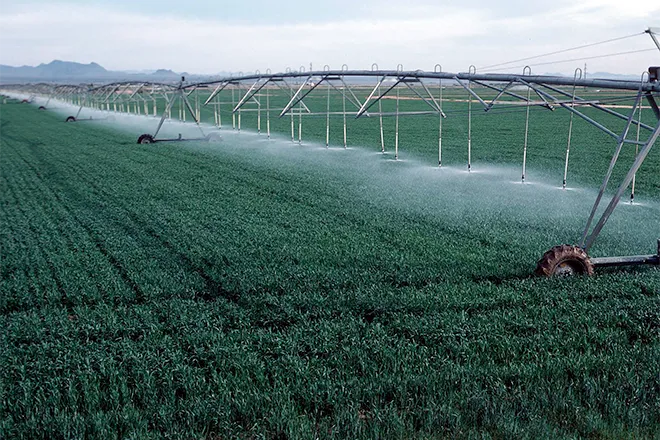
Climate change contributes to shift in Lake Erie’s harmful algal blooms
© Stephen Barnes - iStock-1751685698
Click play to listen to an abbreviated version of this article.
(Ohio News Connection) Lake Erie's harmful algal blooms have started sooner and had longer peak periods over the past decade compared to earlier years, newly released data shows. Warming temperatures linked to climate change are a cause, according to researchers for NOAA's National Centers for Coastal Ocean Science, with interactions among species likely playing a role as well.
The NOAA scientists discussed the shift and forecast a moderate to above-moderate algal bloom for the lake's western basin this summer during a briefing last month at Ohio State University and Ohio Sea Grant's Stone Laboratory, off the coast of Put-in-Bay on Lake Erie.
Algal blooms occur when cyanobacteria, or blue-green algae, grow out of control due to a combination of excess nutrients, weather patterns and other ecological factors. The blooms can be a serious public health problem because some types of cyanobacteria produce toxins. Microcystin, for example, can lead to skin rashes, gut problems and liver and kidney issues. Relatively high levels of it in August 2014 prompted a two-day shutdown of Toledo's public water supply, which comes from Lake Erie.

"We were certainly caught off guard, and the impact was hundreds of thousands of people were without drinking water," said Sean Corson, director of the National Centers for Coastal Ocean Science. The total economic impact of the 2014 water crisis was around $65 million, he said.
Even when toxic strains aren't the problem, algal blooms can still affect Ohio's lake-focused businesses and other activities. Aside from the ugliness of neon green scum, people can't distinguish between toxic and non-toxic strains by eye. Such uncertainty discourages lake-based activities, such as beach visits and fishing. Blooms also add to costs for water treatment plants.
Out-of-control cyanobacteria don't provide good eating for the rest of the lake's food web, either. And they contribute to so-called dead zones, areas with very low levels of dissolved oxygen that can't support aquatic life.
For more than a decade, NOAA has worked with partners in the state, including the Ohio Sea Grant Program, the National Center for Water Quality Research at Heidelberg University, the Ohio State University and the University of Toledo, to forecast the severity of the blooms in Lake Erie's western basin. It's the shallowest part of the lake, with abundant fish. Water is likely to warm faster and blooms flourish there more readily than elsewhere in the lake. Water in Lake Erie generally moves from west to east.
Last year's bloom was significantly larger than the smaller-than-average event researchers had predicted. So the forecast team took a closer look at the data.
From 2012 through 2023, Lake Erie's algal blooms have generally started in July, compared to the previous decade when blooms usually kicked in during August, said NOAA oceanographer Rick Stumpf, who plays a leading role in the forecasting program. The lake's algal blooms during the past decade also have had longer peak periods, resembling plateaus instead of short spikes.

© iStock - DisobeyArt
"Blooms are starting earlier. They're lasting longer. Their peaks are larger. So, by some measures, they're getting worse," Corson said.
"Temperature is the overall driver," Stumpf said, noting ongoing trends of warmer summers and less ice cover in winters. But it's not a simple matter of warmer water producing the changes. The team's current hypothesis is that the shift to earlier algae blooms with longer peak periods reflects both climate change and ecological interactions.
Diatoms are a type of single-cell algae found in Lake Erie, which play an important part in its food webs. They generally outcompete cyanobacteria for nutrients early in the season, when water is cooler, Stumpf explained. The diatoms provide good eating for tiny lake organisms called zooplankton. Changing conditions in the lake could be increasing the degree to which the zooplankton multiply and feast on the diatoms, perhaps suppressing their populations sooner than in earlier years. By the time that happens, cyanobacteria, which prefer warmer water anyway, may have a clearer path to use extra nutrients in the water and grow out of control.
Research is ongoing to better understand what's been happening, Stumpf said. It could help fine-tune future forecasts. But climate change is definitely a factor in the mix.
"We know that climate is changing. We know that this is happening in states here in the Great Lakes region," Corson said. Changes in Ohio include a trend toward warmer average temperatures and more intense rainfallthat usually increases stormwater runoff.
When soil can't absorb that runoff, it carries nutrients from fertilizers into waterways, along with other pollution. Fertilizer runoff from farms is a major source of both phosphorus and nitrogen, although some amounts also come from places like golf courses and suburban subdivisions.
Researchers are seeing shifts in algal bloom patterns elsewhere in the United States. But "changes are really specific to the individual area where you are," Corson said. Many coastal areas are experiencing warming trends and changes in precipitation patterns, along with shifts in land use that increase the amount of impervious surfaces. "Those are all occurring, and the shapes of the blooms are changing as well," he said.
The Outlook This Summer
The severity of Lake Erie's algal blooms varies from year to year. Factors include the levels of nutrient loadingfrom the Maumee River basin, which covers a large part of northwestern Ohio, along with smaller areas in Indiana and Michigan.
The basin accounts for nearly half of the total phosphorus going into Lake Erie's western basin each year, according to Laura Johnson, who heads the National Center for Water Quality Research. She and others are especially interested in the amount of bioavailable phosphorus reaching the lake's western basin each year. Bioavailable means the phosphorus is in a form algae can use.
Estimates for that loading each spring come from flow data and chemical analyses of samples pulled at stream monitoring equipment in Waterville, which accounts for roughly 96 percent of the watershed. More than 60 percent of the area's total bioavailable phosphorus loading from March 1 through June 23 happened in April, Johnson said.
That month was the wettest on record for the region, and more rainfall generally means more fertilizer runoff. However, it was also a mild winter. Relatively dry soils could absorb a fair amount of the runoff, which prevented "crazy flash floods," Johnson said. Some phosphorus remains in the lake from prior years' discharges.
Stumpf and his team fed information from Johnson's group and other data into three models to estimate how severe this year's algal bloom will be on a scale from 1 to 10. "Three models give you a better chance of bracketing the right result," Stumpf explained.
This year's work also reflects a tweak to account for the changing pattern of earlier starts and longer peaks for Lake Erie's algal blooms. "Now we're training those models on data from 2013 to 2023," Stumpf said. The more current data should improve the models' results.
For this year, NOAA predicted a Level 5 bloom, with a range of 4.5 to 6. Fortunately, Corson said, technology continues to improve ongoing monitoring of algal blooms. Water treatment plants' technology has improved as well, he noted.
"The bloom isn't all over the lake all the time," Stumpf stressed. Wind patterns and other factors determine which areas are affected at any particular time. Checking NOAA's updated forecasts can help for planning recreational activities.
"That's going to show you where the bloom is going," said Chris Winslow, director of Ohio Sea Grant and Ohio State University's Stone Laboratory. The Ohio Department of Health's BeachGuard webpage also reports sampling results for cyanobacteria toxins and E. coli bacteria.
Researchers also advise common sense. If the water appears green and scummy, "keep yourself, your kids and your pets out of the water," Stumpf said. Not all algal blooms have high levels of the toxin-producing strains, but it's not worth taking chances.
Kathiann Kowalski wrote this article for Inside Climate News.

















